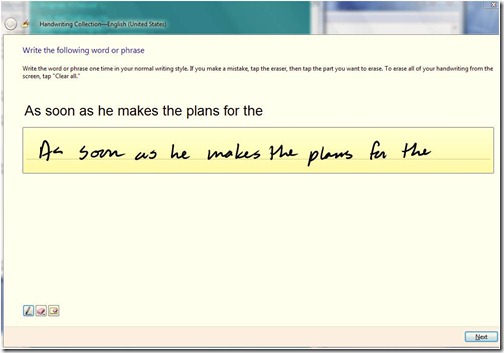Microsoft talks up its handwriting recognition
Strides in development being taken as well as notes

Microsoft has outlined the work it is doing in recognising handwriting, as it continues to work on Windows 7.
Talking on the Engineering Windows 7 blog, a Microsoft Program Manager explained the work being done to ensure that, as more and more people begin to use tablets and touchscreens, handwriting recognition continues to improve.
"Good, naturally written data is essential in developing a high quality recogniser; the recogniser can't be any better than its training set," explains Microsoft's 'Yvonne'.
"The more high quality data we feed into our Neural Network, the more equipped we are to handle sloppy cursive handwriting."
Neural network
"Our Neural Network is a Time-Delay Neural Network (TDNN) that can handle connected letters of cursive scripts. The output of the TDNN is powerful but not good enough when handwriting is sloppy," she adds.
"In order to come within reach of human recognition accuracy, we have to employ information that goes beyond the shape of the letter: we call this the Language Model context.
Get daily insight, inspiration and deals in your inbox
Sign up for breaking news, reviews, opinion, top tech deals, and more.
"The majority of this Language Model context comes in form of the lexicon [sic], which is a wordlist of valid spellings for a given language.
"For many languages, this is the same lexicon that the spellchecker uses. The TDNN and the lexicon work closely together to compute word probabilities and output the top suggestions for the given input."
Stylus
As touchscreens become more common, the potential for using a stylus to make notes becomes increasingly clear.
Although handwriting recognition is nothing new, it has been something of an easy target for jokes over the years.
However, although many touchscreens include, or are complemented by, keyboards, many people still prefer to write their notes in the same way as they would with a normal pen.
Patrick Goss is the ex-Editor in Chief of TechRadar. Patrick was a passionate and experienced journalist, and he has been lucky enough to work on some of the finest online properties on the planet, building audiences everywhere and establishing himself at the forefront of digital content. After a long stint as the boss at TechRadar, Patrick has now moved on to a role with Apple, where he is the Managing Editor for the App Store in the UK.
